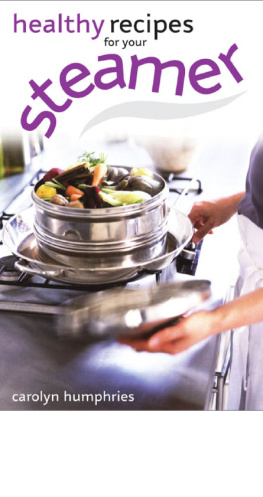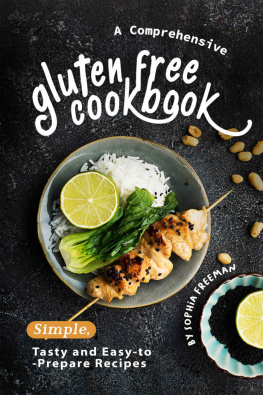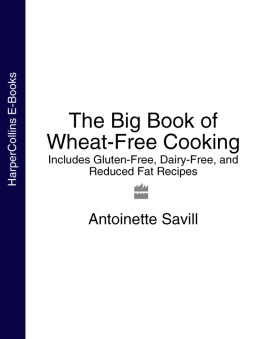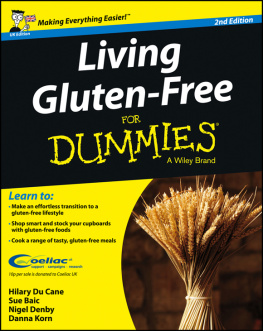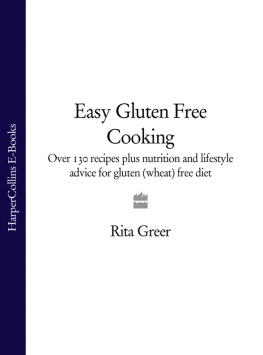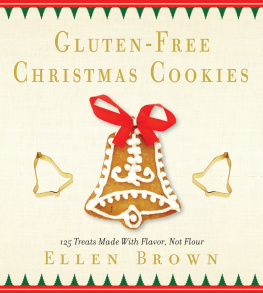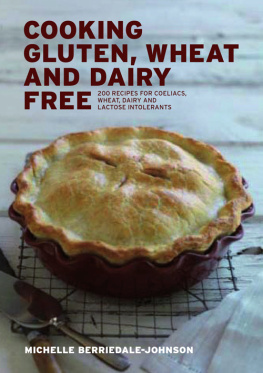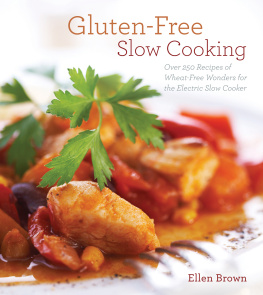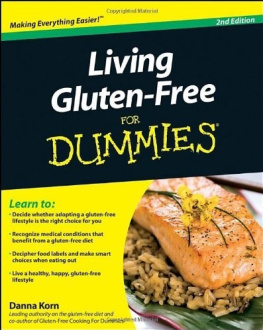
Table of Contents
Introduction
When you are first told that you have to go on a gluten-free or wheat-free diet, it's devastating. It seems as if just about every basic food is banned. But it really isn't so. True, you can't just grab a sandwich or have any old biscuit with your cup of tea, but with the help of this book, you can create all sorts of gorgeous goodies you thought you'd have to give up. There are golden, light sponge cakes, sumptuous quiches and rich and fruity jam tarts. Crusty bread, chocolate brownies and even sausage rolls are all here. So get cooking and enjoy your new, improved and delicious diet.
If you are sensitive to wheat, you can still include other cereals - such as oats, barley and rye - in your diet. Coeliacs, however, have to avoid all of these as well as wheat. To make this book enjoyable for all, every recipe is completely suitable for both coeliacs and those with a wheat sensitivity. For those who can include other cereals in their diet, there is information in the recipe introductions on variations you can try.
Whatever kind of diet you follow, always remember that you need to maintain a good balance of food types. Eat plenty of fresh fruit and vegetables, keep your fat intake to a minimum, avoid too many sugary foods and above all - enjoy!
Wheat Sensitivity
If you are sensitive to wheat, it means you are allergic or intolerant to wheat. It is one of the most common causes of food allergy, but because the symptoms are so diverse, and may also vary greatly in their severity, it is difficult to pinpoint at an early stage. They include muscle stiffness; aching, swollen, red joints; sneezing and watery eyes; stuffed-up or runny nose; migraine; chest pains; nausea; stomach cramps or pains; bloating; skin rashes; swollen throat or trouble in swallowing; sweating; tiredness or apathy; moodiness; irritability or depression; blackouts, panic attacks, flushing, chilling or asthma.
I first came across the condition when my mother was diagnosed with wheat allergy over 20 years ago. She became so poorly that not only was she acutely asthmatic but she was also so debilitated she could only get upstairs on her hands and knees. She was finally rushed into hospital, where, after a multitude of skin tests, blood tests finally confirmed the allergy.
The improvement in her condition when wheat was removed from her diet was phenomenal. And the really big plus is that she has now recovered' from the allergy and can take wheat again (although she never overdoes it and avoids wholewheat foods at all costs). Children often grow out of the problem, but many sufferers have to omit wheat from their diet for life.
Foods to avoid if you are sensitive to wheat
Below is a list of foods which you should either avoid or be wary of if you are sensitive to wheat. Some brands containing some of the ingredients listed here will be wheat-free, while others will contain wheat in one form or another, so read the labels on everything.
- Baking powder, unless labelled gluten-free - some have wheat flour added as an anti-clumping agent
- Blue cheese - some, e.g. Roquefort, are made using mouldy breadcrumbs rather than chemical moulds
- Bread made with wheat flour - this includes naan, chappatis, pittas, tortillas and rye bread
- Breakfast cereals made with wheat, including muesli
- Bulgar (cracked wheat)
- Cereal binders
- Chinese egg noodles
- Citric acid - some brands are made from wheat
- Couscous
- Dextrins - some may contain wheat and you can't tell
- Durum wheat
- Edible starch - may or may not be made from wheat
- Einkorn wheat
- Farina
- Filler
- Fu (dried wheat gluten)
- Gum base
- Ground spices, especially mixed (apple-pie) spice - may contain wheat flour as an anti-clumping agent
- Hard wheat, including Abyssinian
- Kamut (pasta wheat)
- Miso - may contain wheat
- Modified food starch - may be wheat
- Mono- and diglycerides - may contain wheat
- Mustard powder
- Pasta made with wheat
- Semolina (cream of wheat)
- Shredded (chopped) suet in packets - some brands are coated in wheat flour
- Sodium caseinate
- Soy sauce - some brands contain wheat flour
- Spelt (manna)
- Stock cubes - some brands contain wheat flour
- Triticale
- Udon (wheat noodles)
- Wheat bran
- Wheat flours: plain (all-purpose) flour, self-raising (self-rising) flour, strong (bread) flour, wholemeal flour, granary flour, brown flour, pasta flour, etc.
- Wheatgerm
- Wheat nuts
Coeliac Disease
The small intestine is responsible for absorbing all nutrients from our food through the villi (fronds) on the intestinal walls. In coeliac disease, gluten (a part of the protein found in wheat, rye and barley) damages the villi, literally flattening the fronds so that they cannot absorb the nutrients. Consequently, before diagnosis, coeliacs may suffer from anaemia, osteoporosis, fertility problems (male or female), abdominal discomfort, diarrhoea or unusually short stature. They may also, but much more rarely, show the classic symptoms of tiredness, weight loss and looking wasted and malnourished. Once gluten is removed completely from the diet, the villi become restored and function properly again.
Nobody knows how or why it happens but for all sufferers gluten has to be avoided for life. In babies the illness produces foul-smelling, pale stools, wind, bloating and poor weight gain and growth. This usually happens soon after cereals are introduced at around six months. It is not advisable for any baby younger than this to have gluten as a small infant's digestive system is too immature to cope with it. If there is any history of coeliac disease in the family, gluten should not be introduced before the baby is one year old.
It was in the late 1800s that the disease was first noticed and it was called chronic intestinal infection (CII). Then, during the Second World War, children in Holland with CII became much better when all the Dutch wheat was exported to Germany. When wheat was available to them again, they got worse. But it was not until 1950 that gluten was identified as the part of the grain that caused the problems.
Dermatitis herpetiformis is a chronic infection of the skin, causing red, sore itchy patches of pustules or blisters. It is often associated with coeliac disease and means a gluten-free diet for life.
Foods to avoid if you are coeliac
There are many conflicting ideas about what can or can't be tolerated by coeliacs, but the information I have given highlights foods to avoid as well as those to be wary of.
I have based this on the recommendations of the Coeliac Society. If you have any doubts at all about any foods, check with your gastroenterologist or contact the Society.
- All the wheat products mentioned in chapter 1.
PLUS
- Barley
- Barley malt
- Beer
- Brown table sauce
- Caramel colouring - it may be made from barley
- Lager
- Liquorice sweets - these usually contain wheat flour, although liquorice flavouring is safe
- Malt
- Malt syrup
- Oat bran
- Oatmeal
- Oats
- Oyster sauce
- Pearl barley
- Pure malt extract
- Rice malt
- Rye
- Teriyaki sauce
- Tomato ketchup (catsup), some brands - check the label
- Worcestershire sauce
Next page
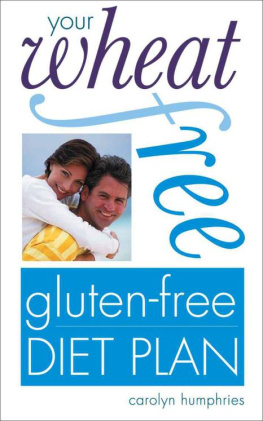
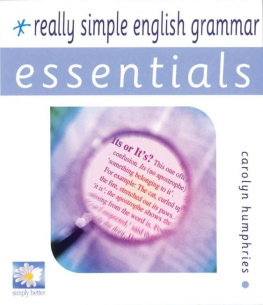
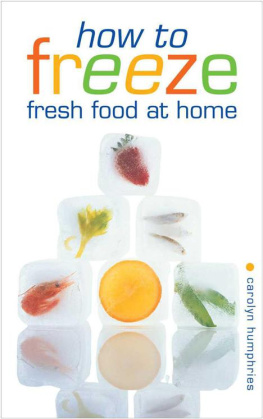
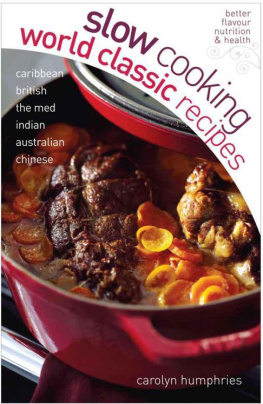
![Humphries - The low carb long term lifestyle : [with a twist of Mediterranean to add zest to your eating]](/uploads/posts/book/104760/thumbs/humphries-the-low-carb-long-term-lifestyle.jpg)
